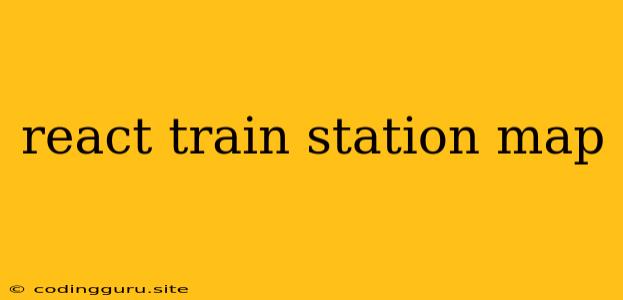Navigating the City with Ease: Building a React Train Station Map
Ever found yourself lost in a sprawling train station, unsure of which platform to head to? Fear not, fellow travelers! With the power of React, we can build an interactive map that guides you through the intricate network of tracks and platforms, making your journey a breeze.
Why React for Train Station Maps?
React is a popular JavaScript library for building user interfaces, known for its efficiency and ease of use. When it comes to creating a dynamic and visually appealing train station map, React is the ideal choice. Here's why:
- Interactive Elements: React allows you to create interactive elements, such as clickable platforms, animated trains, and pop-up information boxes, bringing your map to life.
- Component-Based Architecture: React's component-based architecture lets you break down your map into smaller, reusable parts. This makes your code more organized, maintainable, and easier to update.
- Data Handling: React handles data updates efficiently, ensuring smooth transitions and accurate information display as train schedules change.
- Performance Optimization: React's Virtual DOM efficiently updates only the necessary parts of your map, leading to a fast and responsive user experience.
Building Your React Train Station Map: A Step-by-Step Guide
1. Setting Up the Project:
Start by creating a new React project using Create React App:
npx create-react-app my-train-station-map
cd my-train-station-map
2. Obtaining Station Data:
You'll need data about the train station, including platform locations, train lines, and schedules. You can obtain this from:
- Station Websites: Many train stations provide downloadable data or APIs.
- Open Data Portals: Look for open data initiatives from your city or transportation authority.
- Third-Party Data Providers: Companies like Google Maps or Mapbox offer data services.
3. Choosing Your Mapping Library:
React offers various mapping libraries to render your map visually. Popular options include:
- Leaflet: Lightweight, open-source, and great for simple maps.
- Google Maps: Powerful and widely used with extensive features.
- Mapbox: Customization-focused and offers stunning map styles.
4. Designing Your Map Layout:
Consider the following factors when designing your map layout:
- Clarity: Use clear labels and colors for platforms and lines.
- Scale: Ensure the map is legible for different screen sizes.
- Accessibility: Make your map accessible for users with disabilities.
- User Experience: Design intuitive navigation features, such as zoom and panning controls.
5. Implementing Interactivity:
React components allow you to add interactivity to your map:
- Platform Click Events: Display detailed platform information when a platform is clicked.
- Train Movement Animation: Animate trains moving along their respective lines.
- Search Functionality: Allow users to search for specific platforms or train lines.
6. Integrating Real-Time Data:
To display live train information, use APIs or websockets to fetch and update data dynamically. This will keep your map up-to-date with the latest train schedules.
7. Testing and Optimization:
Thoroughly test your map across different devices and browsers to ensure optimal performance and user experience. Consider optimizing your map for faster loading times and smooth animations.
Example: Creating a Basic Platform Marker
Let's create a simple platform marker using Leaflet, which provides easy-to-use components for rendering map features:
import React, { useState, useEffect } from 'react';
import { MapContainer, TileLayer, Marker, Popup } from 'react-leaflet';
function TrainStationMap() {
const [platformData, setPlatformData] = useState([]);
useEffect(() => {
// Fetch platform data from an API or your data source
fetch('https://api.example.com/platforms')
.then(response => response.json())
.then(data => setPlatformData(data));
}, []);
return (
Platform {platform.name}
Train Lines: {platform.lines.join(', ')}
))}
);
}
export default TrainStationMap;
This code snippet creates a simple map with markers representing platforms, displaying their name and served lines in a popup when clicked.
Conclusion
Building a React train station map is a rewarding project that combines the power of React with the visual appeal of mapping libraries. By following these steps, you can create a comprehensive and user-friendly map that helps travelers navigate complex train stations with ease. Whether you're creating an interactive map for a train station website, a mobile app, or an internal tool, React provides you with the tools you need to bring your vision to life.
